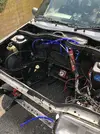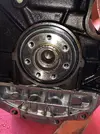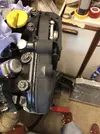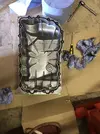Have you put a stainless bolt in that cover? It looks stainless - don't use those in load or stress points like suspension or engine mount points.
The alloys in steel that make it stainless also make it weaker (you never get something for nothing), they're around 75% of the strength of normal steel. Also when you connect stainless steel to steel/ally you create a small battery as they are dissimilar metals. Therefore the current flow takes away from the steel to corrode it more quickly than on it's own. Just because it's shiny doesn't mean it's good!
Stainless steel can also degrade after prolonged exposure to certain environments, in this case being salt and/or heat. Its called chloride stress corrosion cracking, and is basically where chloride ions get in between the metal grains to weaken them, which can then lead to brittle fracture of the material.
TL/DR: Stick with high tensile steel bolts for anything bearing load.











